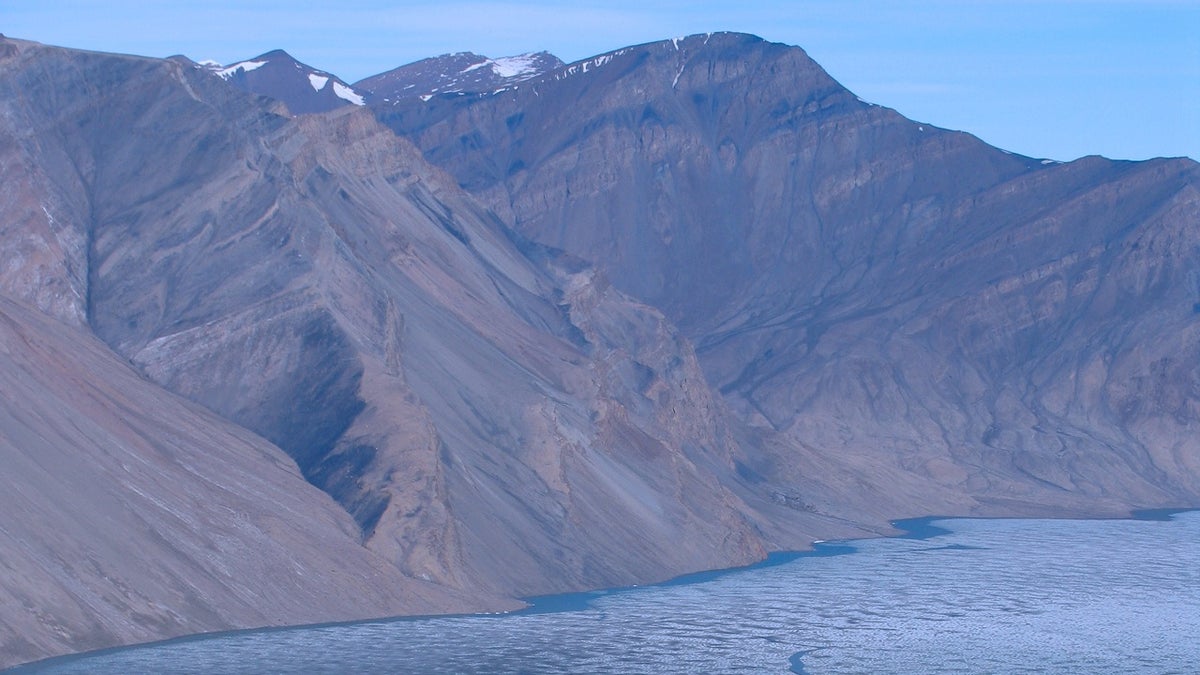
The shores of Buchanan Lake, Axel Heiberg Island, Nunavut, where researchers have discovered sediments deposited shortly after the worst extinction event in Earth's history. (Steve Grasby, University of Calgary/NRCan)
It must have been one hell of an eruption.
About 250 million years ago, hundreds of millions of years before the dinosaurs were wiped from the face of the planet, 95 percent of the primitive life developing in the sea was wiped out -- and 70 percent of the critters evolving on the Earth's surface. And no one knew why -- until now.
Researchers at the University of Calgary have discovered evidence suggesting that massive volcanic eruptions at the time burnt significant volumes of coal, producing choking clouds of ash and dust that had broad impact on global oceans, and may explain the massive devastation, an event known as the Permian extinction.
"Our research is the first to show direct evidence that massive volcanic eruptions -- the largest the world has ever witnessed --caused massive coal combustion, thus supporting models for significant generation of greenhouse gases at this time," said Dr. Steve Grasby, adjunct professor in the University of Calgary's Department of Geoscience and research scientist at Natural Resources Canada.
At the time of the extinction -- which some have labeled "the Great Dying" -- the Earth contained one big land mass, a supercontinent known as Pangaea. The environment ranged from desert to lush forest. Four-limbed vertebrates were becoming more diverse and among them were primitive amphibians, early reptiles and synapsids, the group that would one day include mammals.
Grasby and colleagues discovered layers of coal ash in rocks from Canada's High Arctic mountain range that give the first direct proof to support the chain of tremendous eruptions; they published their findings in the latest issue of the journal Nature Geoscience.
"This could literally be the smoking gun that explains the latest Permian extinction," Grasby said.
There is widespread belief that the impact of a meteorite was at least the partial cause for the end of the dinosaur era, 65 million years ago. But it had been unclear what caused the late Permian extinction. Previous research had suggested massive volcanic eruptions through coal beds in Siberia would generate significant greenhouse gases causing run away global warming, but there was no direct evidence of such events.
The volcanoes, known as the Siberian Traps, are found in northern Russia, centered around the Siberian city of Tura and also encompassing Yakutsk, Noril'sk and Irkutsk. They cover an area just under two million square kilometers, a size greater than that of Europe. The ash plumes from the eruption of the immense chain of volcanoes traveled to Canada's arctic where Grasby and his colleagues found the coal-ash layers.
The coal‑ash particle on the left is from the latest Permian extinction boundary at Buchanan Lake. Nunavut, the particle on the right is from a modern power plant.
"We saw layers with abundant organic matter and Hamed [a fellow researcher] immediately determined that they were layers of coal-ash, exactly like that produced by modern coal burning power plants," said Dr. Benoit Beauchamp, also from the University of Calgary.
The ash, the authors suggest, may have caused even more trouble for a planet that was already heating up, with its oceans starting to suffocate because of decreasing oxygen levels.
"It was a really bad time on Earth. In addition to these volcanoes causing fires through coal, the ash it spewed was highly toxic and was released in the land and water, potentially contributing to the worst extinction event in earth history," Grasby said.








































